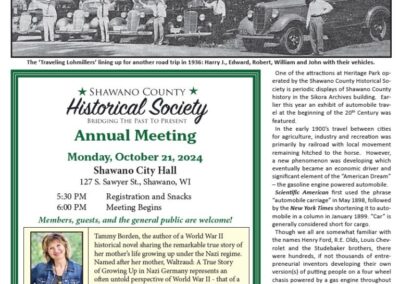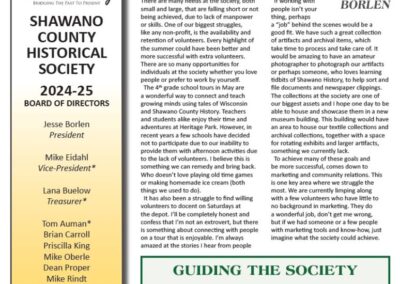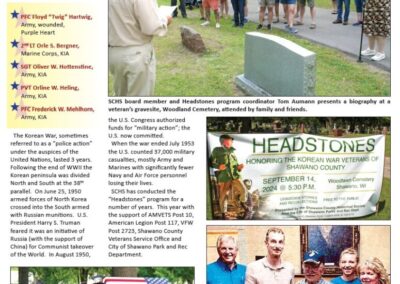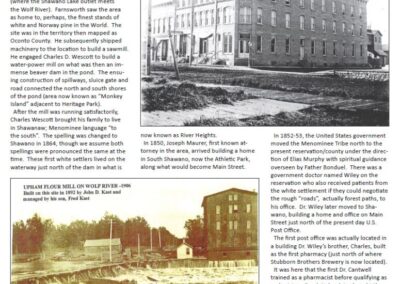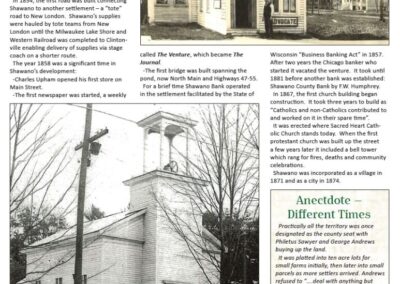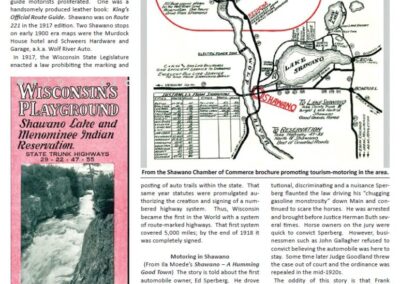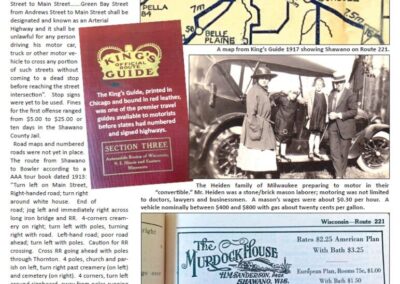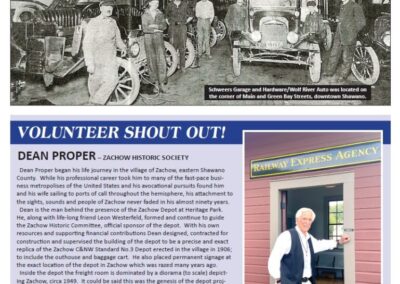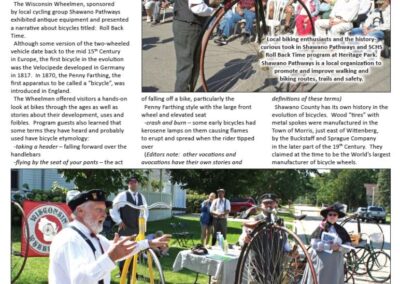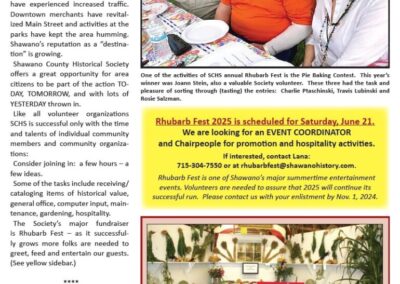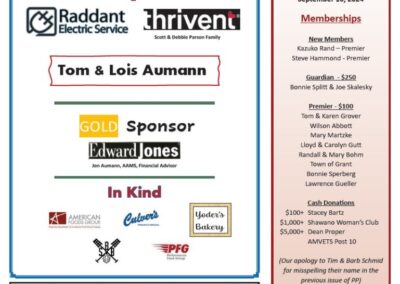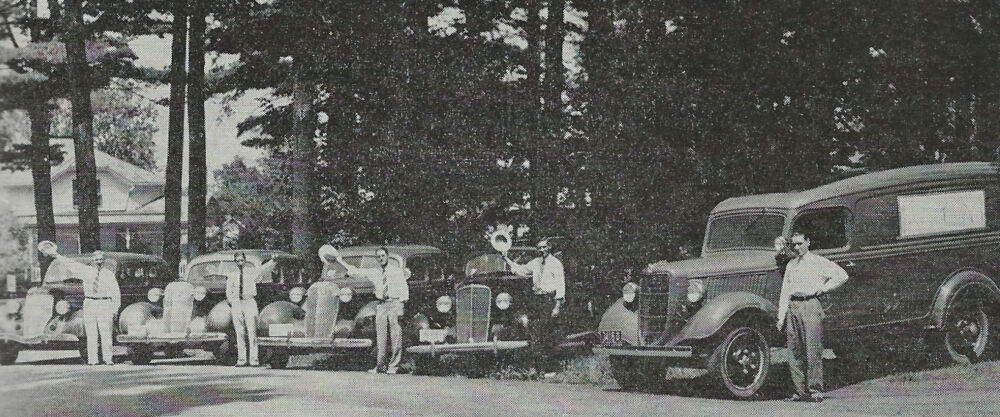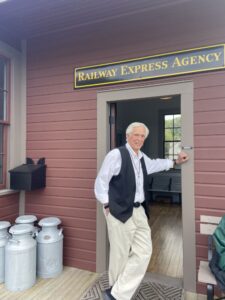Pages
Online Edition
Preservation Press Fall 2024
Early Motoring
One of the attractions at Heritage Park operated by the Shawano County Historical Society is periodic displays of Shawano County history in the Sikora Archives building. Earlier this year an exhibit of automobile travel at the beginning of the 20th Century was featured.
In the early 1900’s travel between cities for agriculture, industry and recreation was primarily by railroad with local movement remaining hitched to the horse. However, a new phenomenon was developing which eventually became an economic driver and significant element of the “American Dream” – the gasoline engine powered automobile.
Scientific American first used the phrase “automobile carriage” in May 1898, followed by the New York Times shortening it to automobile in a column in January 1899. “Car” is generally considered short for cargo.
Though we all are somewhat familiar with the names Henry Ford, R.E. Olds, Louis Chevrolet and the Studebaker brothers, there were hundreds, if not thousands of entrepreneurial inventors developing their own version(s) of putting people on a four-wheel chassis powered by a gas engine through the country and the World. It is estimated there were more than 1900 automobile makers at the turn of the century in the USA.
Travel by “horseless carriage” was difficult as the roads were not fit, the vehicles undependable, service and other accommodations sparse. However, in a classic case of continuous improvement all those problems were quickly remedied.
To venture off on a motor trip in the 1900-20 period meant following trails , or “marked roads” charted by competing automobile clubs, tire manufacturers, oil companies and tourist associations. These entities erected signs along their routes which would meet their self-interest(s). Some cities and recreation areas even paid a fee to have the marked route run to/through them. They were called “auto trails”.
Travel maps, brochures and manuals to guide motorists proliferated. One was a handsomely produced leather book: King’s Official Route Guide. Shawano was on Route 221 in the 1917 edition. Two Shawano stops on early 1900 era maps were the Murdock House hotel and Schweers Hardware and Garage, a.k.a. Wolf River Auto.
In 1917, the Wisconsin State Legislature enacted a law prohibiting the marking and posting of auto trails within the state. That same year statutes were promulgated authorizing the creation and signing of a numbered highway system. Thus, Wisconsin became the first in the World with a system of route-marked highways. That first system covered 5,000 miles; by the end of 1918 it was completely signed.
Motoring in Shawano
(From Ila Moede’s Shawano – A Humming Good Town) The story is told about the first automobile owner, Ed Sperberg. He drove down Main Street one shopping day and his vehicle was so noisy that the farmers’ teams were so scared they went over the hitching posts and started for home. One team’s wagon pole went through the plate glass window of Brauer’s Saloon.
The city then passed an ordinance prohibiting Ed and others from driving an auto on Main St. and Green Bay St. Other streets were so narrow and muddy that City Attorney Charles F. Dillett thought the problem was solved. Believing the law to be unconstitutional, discriminating and a nuisance Sperberg flaunted the law driving his “chugging gasoline monstrosity” down Main and continued to scare the horses. He was arrested and brought before Justice Herman Buth several times. Horse owners on the jury were quick to convict Sperberg. However, businessmen such as John Gallagher refused to convict believing the automobile was here to stay. Some time later Judge Goodland threw the case out of court and the ordinance was repealed in the mid-1920s.
The oddity of this story is that Frank Schweers, who was a member of the City Council, worked for the prosecution of Sperberg and later became one of the area’s leading automobile dealers. He built a large garage and hardware facility on the corner of Main and Green Bay streets. Schweers Garage and Hardware sold Studebaker, Dodge and Overland while his Wolf River Auto Co. sold Buick. Other dealers: Shawano Auto Co. sold Ford, Marotz Brothers sold Oakland and Pontiac, and Jos. Popp and Sons sold Willys-Knight.
The cars were called “Flivvers” or “Tin Lizzies” and were enclosed with isinglass curtains which were put on if the weather called for them.
Albert Engel, Bill Eich, Herman Reichel, Jim Vomastic and Shorty Krenger were a few of the gasoline dealers at the time operating “filling stations”.
On April 1, 1924 the City passed an ordinance giving car owners directions where they should stop: “That Main Street from Fourth Street inclusive to Richmond Street…..Green Bay Street from Franklin Street to Main Street…….Green Bay Street from Andrews Street to Main Street shall be designated and known as an Arterial Highway and it shall be unlawful for any person driving his motor car, truck or other motor vehicle to cross any portion of such streets without coming to a dead stop before reaching the street intersection”. Stop signs were yet to be used. Fines for the first offense ranged from $5.00 to $25.00 or ten days in the Shawano County Jail.
Road maps and numbered roads were not yet in place. The route from Shawano to Bowler according to a AAA tour book dated 1913: “Turn left on Main Street, Right-handed road; turn right around white house. End of road; jog left and immediately right across long iron bridge and RR. 4-corners creamery on right; turn left with poles, turning right with road. Left-hand road; poor road ahead; turn left with poles. Caution for RR crossing. Cross RR going ahead with poles through Thornton. 4 poles, church and parish on left, turn right past creamery (on left) and cemetery (on right). 4 corners, turn left around signboard, away from poles running through woods on very sandy road. Pass creamery and brick church picking up poles. 4 corners; turn right with poles swinging left and right with road just beyond. At Tilleda turn left passing hotel barn (on right) cross iron bridge around mill race. Follow winding, sandy road with poles through woods, avoiding left hand road. Caution for numerous rocks in road on winding grade through the woods. Pick up poles, passing school on left through Bowler.”
*****************
AHOOGA
This was the sound of many vehicles 1908-30, principally on Ford Model T, but also many General Motors autos. The “ahooga” horn was invented by Miller Reese Hutchinson who thought the existing squeeze bulb horns and other devices were too timid, too melodic. He set out to develop a more garish sounding horn after almost hitting a pedestrian.
What gave the klaxon horn, as it was called, the unique sound? There is a diaphragm that gets struck by teeth on a rotating wheel. An electric motor drives it, as the wheel comes up to speed you get the ahoo, and as it slows back down, the ga.
Hutchinson, who worked closely with Thomas A. Edison, also invented the electronic hearing aid. One can readily imagine the correlative comments made at the time.
*****************
PRESIDENT’S MESSAGE – JESSE BORLAN
As summer draws to a close we begin to take stock and look back at the highlights. It began with 4th grade school tours in May, then the start of the Depot Saturday Spotlight tours at the beginning of June. Rhubarb Fest was our biggest event of the season, but let us not forget the Shawano County Fair, Roll Back Time, and Headstones. Not to mention that throughout the summer the society has been abuzz with artifact/archive donations and weddings in the Old Tabor Church. I would say that as a whole the summer of 2024 was very good to us.
With that said however, our great events and successful summer came at a cost. There are many needs at the society, both small and large, that are falling short or not being achieved, due to lack of manpower or skills. One of our biggest struggles, like any non-profit, is the availability and retention of volunteers. Every highlight of the summer could have been better and more successful with extra volunteers. There are so many opportunities for individuals at the society whether you love people or prefer to work by yourself.
The 4th grade school tours in May are a wonderful way to connect and teach growing minds using tales of Wisconsin and Shawano County History. Teachers and students alike enjoy their time and adventures at Heritage Park. However, in recent years a few schools have decided not to participate due to our inability to provide them with afternoon activities due to the lack of volunteers. I believe this is something we can remedy and bring back. Who doesn’t love playing old time games or making homemade ice cream (both things we used to do).
It has also been a struggle to find willing volunteers to docent on Saturdays at the depot. I’ll be completely honest and confess that I’m not an extrovert, but there is something about connecting with people on a tour that is enjoyable. I’m always amazed at the stories I hear from people after they see one of our artifacts or learn something on the tour. It makes up for the small sacrifice of time from your daily life.
If working with people isn’t your thing, perhaps a “job” behind the scenes. We have such a great collection of artifacts and archival items, which take time to process and take care of. It would be amazing to have an amateur photographer to photograph our artifacts or perhaps someone, who loves learning tidbits of Shawano History, to help sort and file documents and newspaper clippings. The collections at the society are one of our biggest assets and I hope one day to be able to house and showcase them in a new museum building. This building would have an area to house our textile collections and archival collections, together with a space for rotating exhibits and larger artifacts, something we currently lack.
To achieve many of these goals and be more successful, comes down to marketing and community relations. This is one key area where we struggle the most. We are currently limping along with a few volunteers who have little to no background in marketing. They do a wonderful job, don’t get me wrong, but if we had someone or a few people with marketing tools and know-how, just imagine what the society could achieve.
****************
GUIDING THE SOCIETY
VISION STATEMENT
The vision of the the Shawano County Historical Society to “enrich people’s lives through history.”
MISSION STATEMENT
The mission of the the Shawano County Historical Society is to “preserve the culture and history or Shawano County by creating a vibrant learning experience and serving as a resource for current and future generations”.
*****************
Headstones – Korean War Vets
Several hundred people participated in September at Woodlawn Cemetery in a “Muster Call” of Shawano County Historical Society’s “Headstones” program honoring Korean War Veterans of Shawano County including families of the tributees:
- PFC Floyd “Twig” Hartwig, Army, wounded, Purple Heart
- 2nd LT Orle S. Bergner, Marine Corps, KIA
- SGT Oliver W. Hottenstine, Army, KIA
- PVT Orline W. Heling, Army, KIA
- PFC Frederick W. Mehlhorn, Army, KIA
The Korean War, sometimes referred to as a “police action” under the auspices of the United Nations, lasted 3 years. Following the end of WWII the Korean peninsula was divided North and South at the 38th parallel. On June 25, 1950 armed forces of North Korean crossed into the South armed with Russian munitions. U.S. President Harry S. Truman feared it was an initiative of Russian (with the support of China) for Communist takeover of the World. In August 1950 the U.S. Congress authorized funds for “military action”; the U.S. now committed.
When the war ended July 1953 the U.S. counted 37,000 military casualties, mostly Army and Marines with significantly fewer Navy and Air Force personnel losing their lives.
SCHS has conducted the “Headstones” program for a number of years. This year with the support of AMVETS Post 10, American Legion Post 117, VFW Post 2723, Shawano County Veterans Service Office and City of Shawano Park and Rec Department.
*****************
Shawano at 150 Years – Back Then
(As the City of Shawano records its 150th year, more about the early years adapted from an article in the Shawano Evening Leader, October 1946. See Preservation Press Spring 2024 for part 1.)
In 1843 Samuel H. Farnsworth paddled up the Wolf River from New London and came upon a Menominee village along the pond (where the Shawano Lake outlet meets the Wolf River). Farnsworth saw the area as home to, perhaps, the finest stands of white and Norway pine in the World. The site was in the territory then mapped as Oconto County. He subsequently shipped machinery to the location to build a sawmill. He engaged Charles D. Wescott to build a water-power mill on what was then an immense beaver dam in the pond. The ensuing construction of spillways, sluice gate and road connected the north and south shores of the pond (area now known as “Monkey Island” adjacent to Heritage Park).
After the mill was running satisfactorily, Charles Wescott brought his family to live in Shawanaw; Menominee language “to the south”. The spelling was changed to Shawano in 1864, though we assume both spellings were pronounced the same at the time. These first white settlers lived on the waterway just north of the dam in what is now known as River Heights.
In 1850, Joseph Mauer, first known attorney in the area, arrived building a home in South Shawano, now the Athletic Park, along what would become Main Street.
In 1852-53, the United States government moved the Menominee Tribe north to the present reservation/county under the direction of Elias Murphy with spiritual guidance overseen by Father Bonduel. There was a government doctor named Wiley on the reservation who also received patients from the white settlement if they could negotiate the rough “roads”, actually forest paths, to his office. Dr. Wiley later moved to Shawano, building a home and office on Main Street just north of the present day U.S. Post Office.
The first post office was actually located in a building Dr. Wiley’s brother, Charles, built as the first pharmacy (just north of where Stubborn Brothers Brewery is now located).
It was here that the first Dr. Cantwell trained as a pharmacist before qualifying as a physician. Frank Naber later bought the property as a drug store and base for developing other businesses in the community.
In 1863 Hiram Wescott settled in Shawano building its first hotel, the Wescott House, subsequently the Murdock House. After it burned April 18, 1948 and the site cleared, the replacement building was called the Woolworth Building, eventually housing Spurgeons Department Store and currently The Stock Market.
Whats A Little Controversy Along With the Growing Pains
There was some controversy about establishing Shawano as the County Seat; county separated from Oconto County Territory and was established February 16,1853. The area north of the pond was in competition with a settlement in the area of the current Highway 22 bridge known as Powell’s Landing. To settle the argument, the County Seat was established at a mid-point and subsequently the Powell Trading Post was moved ‘up to Shawano’ by Herman Nabor.
In 1854, the first road was built connecting Shawano to another settlement – a “tote” road to New London. Shawano’s supplies were hauled by tote teams from New London until the Milwaukee Lake Shore and Western Railroad was completed to Clintonville enabling delivery of supplies via stage coach on a shorter route.
The year 1858 was a significant time in Shawano’s development:
-Charles Upham opened his first store on Main Street.
-The first newspaper was started, a weekly called The Venture, which became The Journal.
-The first bridge was built spanning the pond, now North Main and Highways 47-55.
For a brief time Shawano Bank operated in the settlement facilitated by the State of Wisconsin “Business Banking Act” in 1857. After two years the Chicago banker who started it vacated the venture. It took until 1881 before another bank was established: Shawano County Bank by F.W. Humphrey.
In 1867, the first church building began construction. It took three years to build as “Catholics and non-Catholics contributed to and worked on it in their spare time”.
It was erected where Sacred Heart Catholic Church stands today. When the first protestant church was built up the street a few years later it included a bell tower which rang for fires, deaths and community celebrations.
Shawano was incorporated as a village in 1871 and as a city in 1874.
*****************
Anectdote – Different Times
Practically all the territory was once designated as the county seat with Philetus Sawyer and George Andrews buying up the land.
It was platted into ten acre lots for small farms initially, then later into small parcels as more settlers arrived. Andrews refused to “….deal with anything but petticoats, asserting that they at least knew what they wanted…..” Mrs. Nabor, Mrs. Klosterman and Mrs. Schweers all bought from Mr. Andrews as he refused to sell to their husbands.
Sources: Shawano Evening Leader, October 29, 1946, reporting of a presentation by Caroline Nikolay to the Junior Woman’s Club. Archives, Shawano County Historical Society
*****************
VOLUNTEER SHOUT OUT!
DEAN PROPER – Zachow Historic Society
Dean Proper began his life journey in the village of Zachow, eastern Shawano County. While his professional career took him to many of the fast-pace business metropolises of the United States and his avocational pursuits found him and his wife sailing to ports of call throughout the hemisphere, his attachment to the sights, sounds and people of Zachow never faded in his almost ninety years.
Dean is the man behind of the presence of the Zachow Depot at Heritage Park. He, along with life-long friend Leon Westerfeld, formed and continue to guide the Zachow Historical Committee, official sponsor of the depot. With his own resources and supporting financial contributions Dean designed, contracted for construction and supervised the building of the depot to be a precise and exact replica of the Zachow C&NW Standard No.3 Depot erected in the village in 1906; to include the outhouse and baggage cart. He also placed permanent signage at the exact location of the depot in Zachow which was razed many years ago.
Inside the depot the freight room is dominated by a diorama (to scale) depicting Zachow, circa 1949. It could be said this was the genesis of the depot project. Dean and Leon wanted to construct a diorama based on an aerial photo on the back wall of the Farmers State Bank. However, neither the Bonduel Archives nor Heritage Park, Shawano, had room to place it. So, the depot was conceived and built; completed in 2012
Dean can be found at the depot most summer weekends as facility docent. And, it doesn’t take much persuasion to get him to provided private group tours anytime.
Dean is also on the Board of Directors of the Shawano County Historical Society.
A big SHOUT OUT to volunteer-extraordinaire Dean Proper; keeping history alive through passionate stewardship.
*****************
Roll Back Time on a Bike
On a beautiful late summer afternoon several hundred people attended a program on the grounds of Heritage Park discovering the history of bicycling. Shawano County Historical Society President-Curator Jesse Borlen observed: “…. it was great to see so many folks on our grounds participating in a community event reliving history and experiencing what we have to offer…..”
The Wisconsin Wheelmen, sponsored by local cycling group Shawano Pathways and SCHS, exhibited antique equipment and presented a narrative about bicycles titled: Roll Back Time.
Although some version of the two-wheeled vehicle date back to the mid 15th Century in Europe, the first bicycle in the evolution was the Velocipede developed in Germany in 1817. In 1870, the Penny Farthing, the first apparatus to be called a “bicycle”, was introduced in England.
The Wheelmen offered visitors a hands-on look at bikes through the ages as well as stories about their development, uses and foibles. Program guests also learned that some terms they have heard and probably used have bicycle etymology:
-taking a header – falling forward over the handlebars
-flying by the seat of your pants – the act of falling off a bike, particularly the
Penny Farthing style with the large front wheel and elevated seat
-crash and burn – some early bicycles had kerosene lamps on them causing
flames to erupt and spread when the rider tipped over
(Editors note: other vocations and avocations have their own stories and definitions of these terms)
Shawano County has its own history in the evolution of bicycles. Wood “tires” with metal spokes were manufactured in the Town of Morris, just east of Wittenberg, by the Buckstaff and Sprague Company in the later part of the 19th Century. They claimed at the time to be the World’s largest manufacturer of bicycle wheels.
*****************
Desination Shawano: Be Part of It
In recent years you have probably noticed that the streets of Shawano have experienced increased traffic. Downtown merchants have revitalized Main Street and activities at the parks have kept the area humming. Shawano’s reputation as a “destination” is growing.
Shawano County Historical Society offers a great opportunity for area citizens to be part of the action TODAY, TOMORROW, and with lots of YESTERDAY thrown in.
Like all volunteer organizations SCHS is successful only with the time and talents of individual community members and community organizations:
Consider joining in: a few hours – a few ideas.
Some of the tasks include receiving/cataloging items of historical value, general office, computer input, maintenance, gardening, hospitality.
The Society maintains limited regular office and access hours at the Sikora Archives, 517 North Franklin Street, Shawano, in Heritage Park. Hours: 9 a.m. – Noon. Stop in for a visit – we’ll show you around and review what we do – the opportunities for you to be part of it.
*****************
Rhubarb Fest 2025 is scheduled for Saturday, June 21.
The Society’s major fund-raiser is Rhubarb Fest – as it successfully grows more folks are needed to greet, feed and entertain our guests.
We are looking for an EVENT COORDINATOR and Chairpeople for promotion and hospitality activities.
If interested, contact Lana: 715-304-7550
rhubarbfest@shawanohistory.com
Rhubarb Fest is one of Shawano’s major summertime entertainment events. Volunteers are needed to assure that 2025 will continue its successful run. Please contact us with your enlistment by November 1, 2024.
*****************
Our Thanks for These Donations
(received March 16, 2024 – September 16, 2024)
Memberships
New Members
- Kazuko Rand – Premier
- Steve Hammond – Premier
Guardian – $250
- Bonnie Splitt & Joe Skalesky
Premier – $100
- Tom & Karen Grover
- Wilson Abbott
- Mary Martzke
- Lloyd & Carolyn Gutt
- Randall & Mary Bohm
- Town of Grant
- Bonnie Sperberg
- Lawrence Gueller
Cash Donations
A special thank you to these Lifetime Members who provide additional annual donations to support our mission.
$100+
- Stacey Bartz
$1,000+
- Shawano Woman’s Club
$5,000+
- Dean Proper
- AMVETS Post 10
(Our apology to Tim & Barb Schmid for misspelling their name in the previous issue of PP)
Memorials in memory of
- Daniel Van De Loo
- Maxine Braun
- John Valaskey
- Teresa Tauchen
- Charles & Cleida O’Brien
- Robert Wohler
- Richard Martzke
*****************
2024 CALENDAR OF EVENTS
May 31 – June 1 Sundrop Dayz Beverage stands
June 15 Rhubarb Fest
June-July-August Museum Tours
July 25-26-27 Charlie’s Red Barn
Aug 29 – Sept 2 Shawano County Fair Exhibit
Sept 8 “Roll Back Time”
Sept 15 Headstones: Korean War (Woodlawn Cemetery, Shawano)
Oct 21 Annual Members’ Meeting
be sure to check out our new website: www.shawanohistory.com
*****************
SHAWANO COUNTY HISTORICAL SOCIETY
2023-24 BOARD OF DIRECTORS
Jesse Borlen, President
Mike Eidahl, Vice-President*
Lana Buelow, Treasurer*
Cheryl Tiegs, Secretary
Tom Aumann*
Brian Carroll
Priscilla King
Mike Oberle
Dean Proper
Mike Rindt
Marcalene Rosenow*
Ron Schumacher*
Newslesletter, Jim and Pat Kasten
(*current term ends in 024)
*****************
MEMBERSHIP HAS BENEFITS!
If you aren’t already a member, consider joining now. Membership donations are an important part of generating operating funds. Join now through our website www.shawanohistory.com “Membership” link.
A change is coming October 1st. A base fee of $20.00 will apply for non-members requesting Research Assistance. Research will begin after receipt of payment and covers search time, regardless of whether the search is successful. Staff will spend up to 60 minutes per request plus $.25 per page for copies.
Research requests can be submitted through the “Contact Us” link on our website and completing the Research Assistance form with your questions or comments.
*****************
Guiding The Society
VISION STATEMENT
The vision of the the Shawano County Historical Society to “enrich people’s lives through history”.
MISSION STATEMENT
The mission of the the Shawano County Historical Society is to “preserve the culture and history or Shawano County by creating a vibrant learning experience and serving as a resource for current and future generations”.
*****************
WAYS YOU CAN HELP US FINANCIALLY
- Membership* Consider upgrading to a higher membership level when you receive your annual renewal information by mail. Encourage friends and family to join.
- Cash Donations* Monetary donations help us maintain historical documents and artifacts, adhere to professional museum and archival standards, maintain museum buildings, and pay operating expenses.
- In-kind Donations. Donations of goods and services allow us to keep operating expenses low and use the funds we raise for our programs and historic preservation.
- Other Ways to Donate
- Utilize employer donation matching programs to benefit SCHS, such as Benevity Causes (Prudential), Thrivent Your Cause, Prevea Circle of Giving, ThedaCare community volunteer program.
- Designate SCHS to receive merchant charity donations, such as Amazon Smile and Thrivent Choice Dollars.
- Memorials on behalf of a missed loved one
- Community Foundation grants
- A gift of appreciated stocks, bonds, or real estate to the SCHS eliminates federal taxes on capital gains.
- Use your required minimum distribution from your IRA as a tax free gift.
- Make the SCHS a beneficiary of a percentage of your IRA, 401k, annuity, will, or trust.
Membership and Donations available online at www.shawanohistory.org

